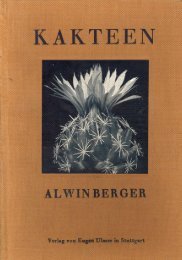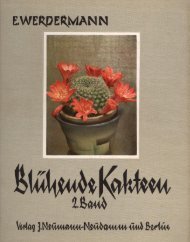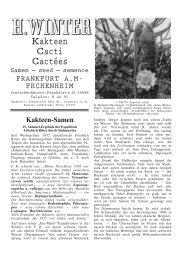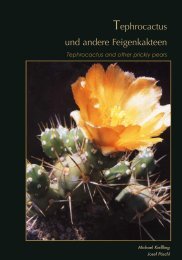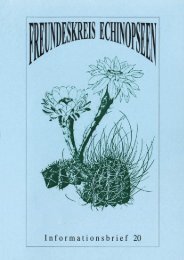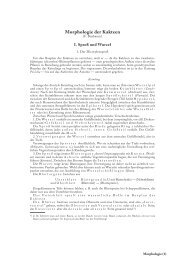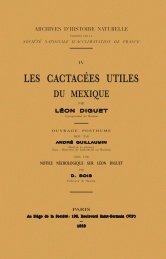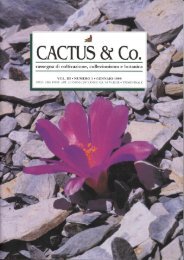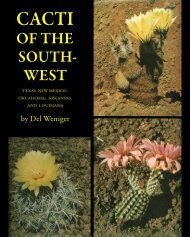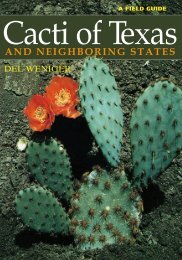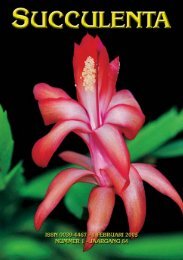- Page 1: This is a sample cover page
- Page 4: Olding, Esq., of the Peninsular and
- Page 7: little to the correct knowledge of
- Page 10: healthy offsets. The original plant
- Page 16: lepidote on both sides, especially
- Page 19: anaceous, spinoso-dentate, red, mor
- Page 22: Peduncle erect, central, a foot lon
- Page 25: des c r . Acaulescent, stoloniferou
- Page 28: paratively soft and pliable in text
- Page 31 and 32: the health and vigour of the indivi
- Page 33 and 34: naturalized ever since the sixteent
- Page 35: Europe as that which is extracted f
- Page 38: and concealing the peduncle and bas
- Page 41: Reigate, who has kindly communicate
- Page 44: of 4-5 inches above the dilated bas
- Page 47: greenish-yellow, an inch and a half
- Page 50: figure has been obtained was receiv
- Page 53: variable in shape, straight or falc
- Page 56: same with A. dealbata, Lemaire, a p
- Page 59: the extremity, the substance thick,
- Page 62 and 63:
to it by Mr. Kellock. It may, howev
- Page 65 and 66:
Ta b . 8746. AGAVE F o u r c r o y
- Page 67:
osette throws out suckers; the pani
- Page 70 and 71:
areas, and Mr. Vicenzo Ricasoli, in
- Page 73 and 74:
Ta b . 5333. AGAVE g l a u c e s c
- Page 76 and 77:
Ta b . 7527. AGAVE has e l o F F i
- Page 79 and 80:
Ta b . 8481. AGAVE hay n a l d i i
- Page 81:
middle of the leaf 2 1 — 2 -4 1
- Page 84:
to be conspecific with the A. inæq
- Page 87:
des c r . Acaulescent. Leaves thirt
- Page 90:
tenflor., xxii. 214), with the sanc
- Page 93:
Agave from Mrs. M‘Donald, of Hond
- Page 96:
small, deltoid, brown. Peduncle fif
- Page 99:
long; lobes green, half as long aga
- Page 102:
acquainted with while under the car
- Page 105:
laciniæ of the perianth. Anthers l
- Page 108 and 109:
means of which it has been propagat
- Page 111 and 112:
Ta b . 7757. AGAVE pea c o c k i i
- Page 114 and 115:
Ta b . 8429. AGAVE p r o T u b e r
- Page 117 and 118:
Ta b . 6292. AGAVE (l i T æ a ) sa
- Page 120 and 121:
Ta b . 5493. AGAVE sau n d e r s i
- Page 123 and 124:
Ta b . 5641. AGAVE s c h i d i g e
- Page 126 and 127:
Ta b . 7567. AGAVE sch o T T i . Na
- Page 129 and 130:
Ta b . 4950. AGAVE s T r i a T a .
- Page 132 and 133:
Ta b . 6655. AGAVE u n i v iT T a T
- Page 135 and 136:
[ 1157 ] Agave Virginica. Spike‑F
- Page 138 and 139:
Ta b . 8501. AGAVE W a r e l l i a
- Page 140:
acts similar to those of the scape
- Page 143:
of flowering, spreading, narrowly o
- Page 146 and 147:
fig. 125, and Baker, Handb. Amaryll
- Page 149 and 150:
Ta b . 5660. AGAVE x y l o n a c a
- Page 152 and 153:
Ta b . 5213. AGAVE y u c c æ F o l
- Page 155 and 156:
Ta b . 7712. ALOE a b y s s i n i c
- Page 158 and 159:
Ta b . 6620. ALOE a b y s s i n i c
- Page 161 and 162:
( 2369 ) alo e a c i n a c i F o l
- Page 164 and 165:
( 2517 ) alo e a F r i c a n a , b.
- Page 167 and 168:
[ 1452 ] Aloe albicans. Hard‑leav
- Page 170 and 171:
Ta b . 5210. ALOE a l b o -ci n c T
- Page 173 and 174:
[ 756 ] Aloe Arachnoides. Spider‑
- Page 176:
[ 1314 ] Aloe arachnoides. (g) reti
- Page 180 and 181:
[ 1306 ] Aloe arborescens. Narrow
- Page 183 and 184:
Ta b . 8663. aloe a r b o r e s c e
- Page 186 and 187:
Ta b . 6848. ALOE b a i n e s i i .
- Page 189 and 190:
Ta b . 7948. ALOE bau m i i. Native
- Page 192 and 193:
Ta b . 7399. ALOE b r a c h y s T a
- Page 195 and 196:
Ta b . 7915. ALOE cam e r o n i . N
- Page 198 and 199:
Ta b . 8134. ALOE c a m p y l o s i
- Page 201 and 202:
[ 1331 ] Aloe carinata (a). Keel‑
- Page 204 and 205:
Ta b . 6301. ALOE c h i n e n s i s
- Page 207 and 208:
Ta b . 8790. ALOE c o n c i n a . Z
- Page 210 and 211:
Ta b . 6377. ALOE coo p e r i . Nat
- Page 213 and 214:
Ta b . 5812. ALOE (ga s T e r i a )
- Page 216:
[ 802 ] Aloe Cymbiformis. Tender‑
- Page 219:
fariously imbricate, quite horizont
- Page 222:
ſpecies. He has quoted the ſame
- Page 225:
May as its flowering season, but pr
- Page 228:
Specific Character and Synonyms. AL
- Page 231:
obscure vertical whitish lines and
- Page 234:
cence three feet high in the specim
- Page 237:
clasping base, tapering gradually t
- Page 240:
appearing like little white puſtul
- Page 244 and 245:
Ta b . 7386. ALOE kir k i i. Native
- Page 247:
Ta b . 7624. ALOE l e p T o p h y l
- Page 251 and 252:
Added end paranthesis [ 1322 ] Aloe
- Page 254:
[ 838 ] Aloe Lingua, var. b. Crassi
- Page 257:
long lax racemes, the side ones spr
- Page 260:
green, with copious lines and oblon
- Page 264 and 265:
[ 815 ] Aloe Margaritifera (v. medi
- Page 267 and 268:
[ 1360 ] Aloe Margaritifera (g); mi
- Page 270 and 271:
Ta b 8484 ALOE mar l o T h i i . So
- Page 273 and 274:
( 2272 ) alo e mi c r o c a n T h a
- Page 276:
[ 1354 ] Aloe mirabilis. Rough‑le
- Page 279:
part becomes woody and naked; leave
- Page 282:
We do not find the preſent plant d
- Page 285 and 286:
5-nerved, the inner membranous and
- Page 287:
Ta b . 7834. ALOE o l i g o s p i l
- Page 290:
Descr.—A stemless plant. Leaves i
- Page 293:
diameter, pendent; bark scaly; inte
- Page 296:
“there is a variety of this ſort
- Page 300 and 301:
Ta b . 6596. ALOE per r y i . Nativ
- Page 303:
[ 1323 ] Aloe picta. Spotted‑leav
- Page 307 and 308:
Ta b . 6705. ALOE p r a T e n s i s
- Page 310 and 311:
[ 1345 ] Aloe Radula. Rasp‑leaved
- Page 313:
[ 1353 ] Aloe Recurva. Recurved Alo
- Page 317 and 318:
[ 1278 ] Aloe rhodacantha. Red‑sp
- Page 320:
[ 1337 ] Aloe Rigida. Stiff‑leave
- Page 323:
segments are much longer than the t
- Page 326:
A. maculoſa: (moucheté.) Lam. Enc
- Page 330 and 331:
Ta b . 7667. ALOE sch W e i n F u r
- Page 333 and 334:
[ 1415 ] Aloe serrulata. Saw‑leav
- Page 336 and 337:
[ 1474 ] Aloe Soccotrina (b.) Purpu
- Page 339 and 340:
Ta b . 8448. ALOE sTe u d n e r i .
- Page 341:
narrowed to the acute point, with a
- Page 344:
in a dense rosette, lanceolate, hal
- Page 348:
[ 837 ] Aloe Verrucosa. Warted Aloe
- Page 352 and 353:
[ 814 ] Aloe Viscosa. Triangular Al
- Page 355:
[ 1368 ] Anacampseros arachnoides.
- Page 358:
cloſely allied ſpecies, all nativ
- Page 361:
for “Apteranthes Numidiea, Durieu
- Page 365 and 366:
Ta b . 4413. ASCLEPIAS d o u g l a
- Page 368 and 369:
( 4106 ) asc l e p i a s v e s T i
- Page 371 and 372:
Ta b . 6641. BESCHORNERIA b r a c T
- Page 374 and 375:
Ta b . 6768. BESCHORNERIA dec o s T
- Page 377 and 378:
Ta b . 6091. BESCHORNERIA Ton e l i
- Page 380 and 381:
Ta b . 4642. BESCHORNERIA T u b i F
- Page 383 and 384:
BESCHCORNERIA -> BESCHORNERIA Ta b
- Page 386 and 387:
Ta b . 5203. BESCHORNERIA y u c c o
- Page 389 and 390:
Ta b . 5270. BILLBERGIA b i v i T T
- Page 392 and 393:
( 2892 ) bil l b e r g i a c r u e
- Page 395 and 396:
Ta b . 6937. BILLBERGIA d e c o r a
- Page 398 and 399:
Ta b . 6632. BILLBERGIA eup h e m i
- Page 401 and 402:
Ta b . 5090. BILLBERGIA lib o n i a
- Page 404 and 405:
it it -> it Ta b . 5114. Bilbergias
- Page 407 and 408:
Ta b . 6423. BILLBERGIAS n u T a n
- Page 410 and 411:
Ta b . 5502. BILLBERGIA o l e n s .
- Page 413 and 414:
Ta b . 6342. BILLBERGIA p a l l e s
- Page 416 and 417:
Ta b . 6670. BILLBERGIA por T e a n
- Page 419 and 420:
( 3304 ) bil l b e r g i a p u r p
- Page 422 and 423:
Ta b . 4883. BILLBERGIA r h o d o c
- Page 425 and 426:
Ta b . 5647. BILLBERGIA s p h a c e
- Page 428 and 429:
Ta b . 4756. BILLBERGIA T h y r s o
- Page 431 and 432:
Ta b . 4835. BILLBERGIA WeT h e r e
- Page 434 and 435:
Ta b . 6137. BOUCEROSIA m a r o c c
- Page 437 and 438:
Ta b . 5607. BRACHYSTELMA bar b e r
- Page 440 and 441:
( 3016 ) bra c h y s T e l m a cr i
- Page 443 and 444:
Ta b . 8817. BRACHYSTELMA F o e T i
- Page 446 and 447:
Ta b 8670 BRACHYSTELMA o i a n T h
- Page 449 and 450:
[ 1409 ] Bryophyllum calycinum. Pen
- Page 452 and 453:
Ta b . 7856. BRYOPHYLLUM c r e n a
- Page 455 and 456:
Ta b . 5147. BRYOPHYLLUM p r o l i
- Page 458 and 459:
Ta b . 7014. CARAGUATA and r e a n
- Page 461 and 462:
Ta b . 7137. CARAGUATA a n g u s T
- Page 464 and 465:
Ta b . 7359. CARAGUATA c o n i F e
- Page 467 and 468:
Ta b . 6675. CARAGUATA m u s a i c
- Page 470 and 471:
Ta b . 6765. CARAGUATA s a n g u i
- Page 473 and 474:
Ta b . 6059. CARAGUATA zah n i i .
- Page 476 and 477:
Ta b . 7274. CARALLUMA c a m p a n
- Page 479 and 480:
Ta b . 8267. CARALLUMA n e b r o W
- Page 482 and 483:
Ta b . 5173. CENTROSTEMMA m u l T i
- Page 485 and 486:
Ta b . 6315. CEROPEGIA b a r k l e
- Page 488 and 489:
Ta b . 5407. CEROPEGIA boW k e r i
- Page 491 and 492:
Ta b . 4349. CEROPEGIA cum i n g i
- Page 493:
Adition in vol. 73, (p. 268 in Bota
- Page 496:
supported on cylindrical, curve, fu
- Page 499:
grows in a dry district, and requir
- Page 502:
for the lobes continue to adhere at
- Page 505:
urgh Botanic Garden, where it flowe
- Page 508:
north of Natal, and the plant conse
- Page 511:
extremely handsome, and very curiou
- Page 514:
des c r . A lofty glabrous climber.
- Page 517:
linear-lanceolate, not half an inch
- Page 520:
two to three lines long, thickened
- Page 523:
lobes, of which there is no trace i
- Page 526:
ase of the corolla. Corolla with th
- Page 529:
part of the segments of the limb de
- Page 532:
curved outwards, presenting a star-
- Page 535:
an inch to one inch long, and as mu
- Page 538:
It is not improbable, however, that
- Page 541:
upwards: limb not a third part the
- Page 544:
filaments pass through a hairy ring
- Page 547:
spreading, sessile, two-thirds to o
- Page 550:
acute. Flowers pedicillate, pendulo
- Page 553:
oad, leaf-like, lanceolate, or oblo
- Page 556:
prominent scars of fallen leaves, t
- Page 560 and 561:
Ta b . 7918. COTYLEDON (Echeveria)
- Page 563 and 564:
Ta b . 7713. COTYLEDON (ech e v e r
- Page 566 and 567:
Ta b . 6417. COTYLEDON r a m o s i
- Page 569 and 570:
Ta b . 5801. COTYLEDON s a l z m a
- Page 572 and 573:
Ta b . 8445. COTYLEDON s u b r i g
- Page 575 and 576:
Ta b . 6235. COTYLEDON T e r e T i
- Page 578 and 579:
Ta b . 7931. COTYLEDON u n d u l a
- Page 580:
Descr.—A succulent, erect shrub,
- Page 583:
wealthy and even the poorer classes
- Page 586:
y supplying dry tropical conditions
- Page 589:
flesh-colour. Anthers red. Hypogyno
- Page 592:
Germens five, cohering: ſtyles div
- Page 596:
[ 384 ] Crassula Cotyledon. Tree Cr
- Page 600 and 601:
( 2035 ) cra s s u l a F a l c a T
- Page 603:
( 2178 ) cra s s u l a j a s m i n
- Page 607 and 608:
Ta b . 6044. CRASSULA p r o F u s a
- Page 610 and 611:
Ta b . 7665. CRASSULA p y r a m i d
- Page 613 and 614:
Ta b . 5393. CRASSULA r o s u l a r
- Page 616 and 617:
Ta b . 6068. CRASSULA s a x i F r a
- Page 619 and 620:
( 2356 ) cra s s u l a v e r s i c
- Page 622 and 623:
Ta b . 7749. DASYLIRION q u a d r a
- Page 625 and 626:
Ta b . 5030. DASYLIRIUM a c r o T r
- Page 627:
acemes. Pedicels short, jointed a l
- Page 630:
mens which flowered at Kew during t
- Page 633:
The Kew Herbarium contains a specim
- Page 636:
and fleshy, semiglobose, pale green
- Page 639:
escent, almost as thick as a gooseq
- Page 642:
Mr. she p h e r d , the early leave
- Page 645:
form laciniæ, or appendages, most
- Page 648:
the leaves between the angles are r
- Page 651:
de s c r . Stem six to ten inches h
- Page 654:
of Cambridge, which flowered there
- Page 657:
imperfectly two lipped. Filaments m
- Page 660:
The plant requires a stove temperat
- Page 663:
lobes ovate-acuminate, erect-spread
- Page 666:
one eight or nine inches long; pedi
- Page 669:
des c r . A stemless aloe-like herb
- Page 672:
1832. It is very handsome, and flow
- Page 675:
gradually upwards into a very slend
- Page 678:
the foliage. The Glasgow Garden has
- Page 681:
esuscitated Echeveria, which as def
- Page 684:
short, campanulate tube, and five s
- Page 687:
des c r . Roots fibrous. Stems tuft
- Page 690:
lines in diameter, dark purple spot
- Page 693:
terminated by a spine that exceeds
- Page 696:
subulate teeth, green on the under
- Page 700 and 701:
( 2258 ) eup h o r b i a e p i T h
- Page 703 and 704:
( 2624 ) eup h o r b i a g l o b o
- Page 706 and 707:
[ 1494 ] Euphorbia Ipecacuanhæ. Em
- Page 709 and 710:
( 3673 ) eup h o r b i a j a c q u
- Page 712:
[ 1305 ] Euphorbia Mellifera. Honey
- Page 716:
[ 1747 ] Euphorbia Variegata. Pye
- Page 719:
ia is represented by a hundred or m
- Page 722 and 723:
The species here figured, F. splend
- Page 725 and 726:
Ta b . 6543. FOURCROYA c u b e n s
- Page 728 and 729:
Ta b . 5163. FOURCROYA F l a v o -v
- Page 731 and 732:
Ta b . 5519. FOURCROYA l o n g æ v
- Page 733:
inches across, white with a greenis
- Page 736:
cultivated at Kew, where it was rec
- Page 739:
thick, ensiform, long acuminate, te
- Page 742:
Leaves in a dense rosette, ensiform
- Page 745:
lower portion. At Kew F. elegans ha
- Page 748:
at Palermo in the year 1877, and as
- Page 751:
merous alternate branches, again di
- Page 754:
Perianth an inch long, bright pink;
- Page 757:
de s c r . An annual, humble, tufte
- Page 760:
of the leaves, of the calyx-lobes,
- Page 763:
de l a b è c h e , and many others
- Page 766:
sheathing base, the rest broadly ch
- Page 769:
limb. The only species of Haworthia
- Page 772:
upper. Stamens included in the peri
- Page 775:
Cape Botanic Gardens, damped off as
- Page 778:
Descr.—A bushy, succulent perenni
- Page 781:
obtained from Henkries, near the Or
- Page 784:
des c r . A succulent glabrous twin
- Page 787:
lobes. Alternating with these angle
- Page 790:
five, broad, obtuse, very short lob
- Page 793:
Corolla pale yellow-green, rotate,
- Page 796:
described species, which, with a fe
- Page 799:
Blume observes, is acrid, and excit
- Page 802:
acute at the point, very indistinct
- Page 805:
account of its affinity to H. coria
- Page 808:
or oblanceolate, acute or acuminate
- Page 811:
produced from different parts of it
- Page 814:
coronæ stamineæ super antheras pr
- Page 817:
should hardly have deemed the prese
- Page 820:
specimens. I have examined these in
- Page 823:
old leaves at the base of the plant
- Page 826:
Corolla rotate, ashy-brown, pubesce
- Page 829:
and semiterete beneath. The umbel o
- Page 832:
with ascending divaricate green cyl
- Page 835:
several of its congeners it is almo
- Page 838:
third of an inch long, deltoid, acu
- Page 841:
cymes; pedicels short, glabrous. Ca
- Page 844:
Descr.—Stems short, two to three
- Page 848 and 849:
[ 604 ] Jatropha Panduræfolia. Fid
- Page 851 and 852:
Ta b . 4376. JATROPHA p o d a g r i
- Page 854 and 855:
Ta b . 7765. KALANCHOE ben T i i .
- Page 857 and 858:
Ta b . 7987. KALANCHOE dye r i . Na
- Page 860 and 861:
Ta b . 7769. KALANCHOE F a r i n a
- Page 863 and 864:
Ta b . 7595. KALANCHOE F l a m m e
- Page 866 and 867:
Ta b . 5460. KALANCHOE g r a n d i
- Page 869 and 870:
Ta b . 7871. KALANCHOE Kirkii. Nati
- Page 872 and 873:
Ta b . 7333. KALANCHOE m a r m o r
- Page 875 and 876:
Ta b . 7831. KALANCHOE s o m a l i
- Page 878 and 879:
Ta b . 7678. KALANCHOE T h y r s i
- Page 881 and 882:
Ta b . 6904. karaTas a c a n T h o
- Page 884 and 885:
Ta b . 7570. KNIPHOFIA b r e v i F
- Page 887 and 888:
Ta b . 8545. KNIPHOFIA carinata. So
- Page 890 and 891:
Ta b . 5946. KNIPHOFIA c a u l e s
- Page 893 and 894:
Ta b . 6569. KNIPHOFIA c o m o s a
- Page 896 and 897:
Ta b . 6742. KNIPHOFIA F o l i o s
- Page 899 and 900:
Ta b . 6716. KNIPHOFIA lei c h T l
- Page 902 and 903:
Ta b . 7623. KNIPHOFIA l o n g i c
- Page 905 and 906:
Ta b . 6167. KNIPHOFIA mac o W a n
- Page 908 and 909:
Ta b . 7293. KNIPIHOFIA m o d e s T
- Page 911 and 912:
Ta b . 7832. KNIPHOFIA m u l T i F
- Page 914 and 915:
Ta b . 7412. KNIPHOFIA nor T h i æ
- Page 917 and 918:
Ta b . 7269. KNIPHOFIA p a u c i F
- Page 920 and 921:
Ta b . 6116. KNIPHOFIA roo p e r i
- Page 923:
Ta b . 7706. KNIPHOFIA r u F a . Na
- Page 926:
plants he has seen. Mr. A. Berger h
- Page 929:
ovate. Stamens biseriate, all disti
- Page 932:
has been cultivated in these Garden
- Page 935:
oblong-cylindrical, a foot or more
- Page 938:
long, about three inches broad at t
- Page 941:
in June, 1833, by Mr. aiT o n . Mr.
- Page 944:
seeds and collections of dried plan
- Page 947:
marked with pale yellowish spots, o
- Page 950:
Sonder (‘Flora Capensis,’ v. 2.
- Page 954:
[ 262 ] Mesembryanthemum Aureum. Go
- Page 958:
[ 59 ] Mesembryanthemum Bicolorum.
- Page 961:
the inspection of the public. It fl
- Page 964:
I have named this beautiful species
- Page 967:
soft and fleshy; papillæ in rows,
- Page 970:
flowers, and, which affords a good
- Page 973:
may eventually be found to be neces
- Page 977 and 978:
Ta b . 8783. MESEMBRYANTHEMUM e d u
- Page 980 and 981:
Ta b . 8776a. MESEMBRYANTHEMUM F u
- Page 982 and 983:
Ta b . 8776b. MESEMBRYANTHEMUM eli
- Page 985 and 986:
[ 1663 ] Mesembryanthemum inclauden
- Page 988 and 989:
Ta b . 6057. MESEMBRYANTHEMUM i n T
- Page 991:
[ 448 ] Mesembryanthemum Micans. Gl
- Page 995 and 996:
Ta b . 8814. MESEMBRYANTHEMUM n o b
- Page 998:
[ 1647 ] Mesembryanthemum obcordell
- Page 1001:
and very white, though not glaucous
- Page 1004:
plant not only from M. lacerum, but
- Page 1008:
[ 396 ] Mesembryanthemum Spectabile
- Page 1011:
the base; branches annual, diffuse
- Page 1014 and 1015:
assistance of the Percy Sladen Trus
- Page 1016:
without odour. The species thrives
- Page 1019 and 1020:
from the coast. From M. albipunctat
- Page 1021:
plant was not M. tigrinum, but no s
- Page 1025 and 1026:
Ta b . 6077. MESEMBRYANTHEMUM T r u
- Page 1028:
[ 326 ] Mesmbryanthemum Viridifloru
- Page 1031:
M. tenuifolium, the Coral Climber o
- Page 1034 and 1035:
on one side as in Monadenium. Two m
- Page 1037 and 1038:
Ta b . 8348. NEOGLAZIOVIA c o n c o
- Page 1040 and 1041:
Ta b . 6024. NIDULARIUM s p e c T a
- Page 1043 and 1044:
Ta b . 4951. PACHYPHYTUM b r a c T
- Page 1046 and 1047:
Ta b . 5543. PACHYPODIUM s u c c u
- Page 1049:
eases -> reases ( 2642 ) piT c a i
- Page 1052:
twelve to twenty to a flower-stem,
- Page 1055:
over with conspicuous white lepidot
- Page 1058:
probable that there apparent differ
- Page 1061:
laciniis cochleari‑ligulatis, e d
- Page 1065 and 1066:
Ta b . 6600. PITCAIRNIA c o r a l l
- Page 1068 and 1069:
Ta b . 4709. PITCAIRNIA e c h i n a
- Page 1071 and 1072:
Ta b . 4591. PITCAIRNIA e x s c a p
- Page 1074 and 1075:
Ta b . 6318. PITCAIRNIA F l a v e s
- Page 1077:
[ 1462 ] Pitcairnia integrifolia. E
- Page 1080:
oblong-ovate: style rather longer t
- Page 1083:
A native of the Weſt‑Indies; req
- Page 1086:
as thick as one’s finger, between
- Page 1089:
nearly half as long as the corolla.
- Page 1092:
sheathing, elongate-linear-subulate
- Page 1095:
aceme in P. Andreana, Linden (B. M.
- Page 1098:
celled. Style the length of the sta
- Page 1101:
and plants raised in this way reach
- Page 1104:
nated, the margin sometimes a littl
- Page 1107:
on both sides, almost entirely dest
- Page 1110:
interpetiolary in our specimen, lon
- Page 1113:
y a kind of involucre, whose leafle
- Page 1116:
gigantic a size, with such large le
- Page 1119:
The compound spike of flowers upon
- Page 1122:
the scape, ovate in circumscription
- Page 1125:
de s c r. The principal leaves of o
- Page 1128 and 1129:
Tillandsia (including Vriesia). Bak
- Page 1131 and 1132:
Ta b . 4991. PUYA v i r e s c e n s
- Page 1134 and 1135:
Ta b . 5225. PUYA W a r s z e W i c
- Page 1137 and 1138:
Ta b . 5732. PUYA Why T e i . Mr. W
- Page 1140 and 1141:
Ta b . 7148. RHODOSTACHYS a n d i n
- Page 1143 and 1144:
Ta b . 8087. RHODOSTACHYS p i T c a
- Page 1146 and 1147:
Ta b . 6027. SEDUM das y p h y l l
- Page 1149 and 1150:
Ta b . 5924. SEDUM g l a n d u l o
- Page 1152 and 1153:
( 1807 ) sed u m o p p o s i T i F
- Page 1155 and 1156:
Ta b . 8503. SEDUM p i l o s u m .
- Page 1158 and 1159:
Ta b . 6223. SEDUM p u l c h e l l
- Page 1161:
( 2474 ) sed u m s e m p e r v i v
- Page 1164:
It flowers readily in a cool greenh
- Page 1167:
shallow pans, and is suitable for a
- Page 1170:
the flower, having only four segmen
- Page 1174:
[ 507 ] Sempervivum Globiferum. Glo
- Page 1177:
In globiferum the young rosettes ar
- Page 1180:
Our drawing was made from a plant c
- Page 1183:
filaments. These are, however, all
- Page 1187 and 1188:
Ta b . 5593. sempervivum pa i v æ
- Page 1190:
( 1980 ) sem p e r v i v u m sm i T
- Page 1193:
The Hen and Chicken is ſo called f
- Page 1196:
glandular-hairy, many-flowered, spr
- Page 1200 and 1201:
Ta b . 7893. SEMPERVIVUM u r b i c
- Page 1203:
( 1809 ) sem p e r v i v u m v i l
- Page 1207 and 1208:
( 2401 ) sTa p e l i a ba r b a T a
- Page 1210:
[ 1676 ] Stapelia Bufonis. Toad‑f
- Page 1213:
the latter, however, may be reckone
- Page 1217:
[ 1661 ] Stapelia campanulata. Bell
- Page 1220:
green, variegated with purple. Caly
- Page 1224:
[ 1184 ] Stapelia Elegans. Elegant
- Page 1227:
are very ſhort, nearly rounded, wi
- Page 1230:
difference in the stems ; but, in t
- Page 1233:
to the angles of the stem, at once
- Page 1236:
The specimen here represented was s
- Page 1239:
flower, and conſiſts of very long
- Page 1242:
merable small, short, transverse ba
- Page 1245:
corollas are of a uniform dull, dar
- Page 1249 and 1250:
( 1833 ) sTa p e l i a ma c u l o s
- Page 1252 and 1253:
Ta b . 7771. STAPELIA n o b i l i s
- Page 1255 and 1256:
Ta b . 6212. STAPELIA o l i v a c e
- Page 1258:
[ 793 ] Stapelia Pedunculata. Long
- Page 1261:
they appear to be moſt immediately
- Page 1264:
chiefly in the pale sulphur-coloure
- Page 1267:
to flower; but when the period of f
- Page 1271 and 1272:
[ 619 ] Stapelia Radiata. Starry St
- Page 1274:
[ 1397 ] Stapelia Reclinata. Reclin
- Page 1278:
[ 724 ] Stapelia Revoluta. Revolute
- Page 1281:
in De Candolle’s Prodromus, publi
- Page 1285:
[ 26 ] Stapelia Variegata. Variegat
- Page 1289 and 1290:
Ta b . 6220. TALINUM arn o T i i .
- Page 1292 and 1293:
Ta b . 4833. TALINUM p o l y a n d
- Page 1295:
[ 1543 ] Talinum reflexum.Reflex‑
- Page 1298:
gulate, bright lemon-yellow, an inc
- Page 1301:
moist stove, flowered in the winter
- Page 1304:
lanceolate, half an inch long. Peta
- Page 1307:
ase above two inches broad; lamina
- Page 1310:
flowered by W. Wilson Saunders, F.R
- Page 1313:
half long, an inch and a half broad
- Page 1316:
at a meeting of the Floral Committe
- Page 1319:
lanceolate reduced leaves. Flowers
- Page 1322:
cartilaginous. Petals lingulate, vi
- Page 1325:
circumvolute leaflets, scariose: Co
- Page 1328:
merely suspended to the rafters in
- Page 1331:
This plant has great reſemblance t
- Page 1334:
ose-coloured scales, sometimes tipp
- Page 1337:
all sides, they become the large, c
- Page 1340:
des c r . Whole plant a foot or a f
- Page 1343:
erectis, lineari‑ſagittatis; ger
- Page 1346:
Andes, hanging in bunches sometimes
- Page 1349:
succulent plants received from Prof
- Page 1352:
district. The other species, T. fla
- Page 1355:
Eaſily diſtinguiſhed from Uvaria
- Page 1359:
[ 758 ] Tritoma Uvaria. Serrulate
- Page 1362:
merous species of Cissus (Vitis), b
- Page 1365:
leaves and flowers, but no tendrils
- Page 1369 and 1370:
still residing in South-western Afr
- Page 1371 and 1372:
eye, it is so singular.” [This la
- Page 1374 and 1375:
Ta b . 8056. WiTTmackia l i n g u l
- Page 1377 and 1378:
[ 1700 ] Yucca aloifolia. Tall‑st
- Page 1380:
( 2236 ) yuc c a a n g u s T i F o
- Page 1383:
no species, either, with such dense
- Page 1386:
spreading, linear from a suddenly-d
- Page 1390 and 1391:
Ta b . 7197. YUCCA F i l i F e r a
- Page 1393:
( 2662 ) yuc c a gl a u c a . gl a
- Page 1396:
We have never met with a figure of
- Page 1399:
Regel casually mentions that it was
- Page 1402:
green. Expanded perianth milk-white
- Page 1405:
than the leaves. Panicle lax, oblon
- Page 1409 and 1410:
Ta b . 7662. YUCCA Whi p p l e i .



